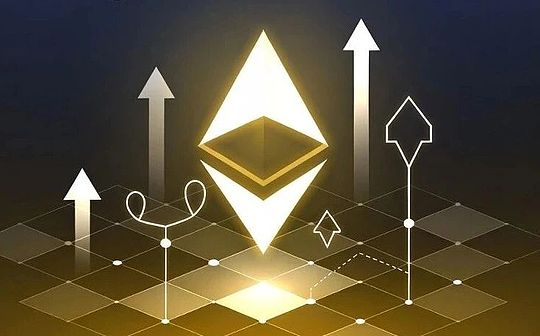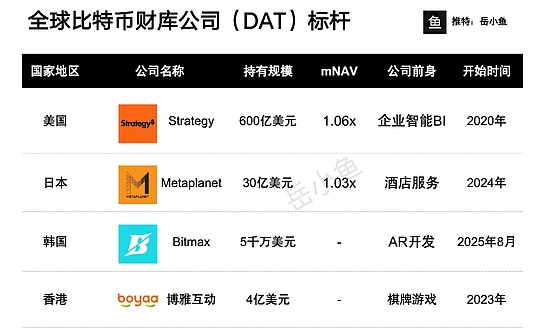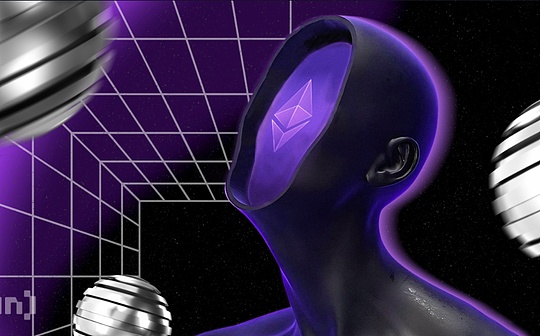
Based on the limitations of the current L2 ecosystem, this article analyzes the specific practices of Taiko and other projects, and demonstrates how the innovative concept of preconfirmation is to optimize the transaction confirmation process and improve user experience.It also reveals the difficulties that the current pre-confirmation technology still needs to be overcome in the development process, including the dual challenges of technological improvement and ecological sustainability.
Original title:“Preconfirmation (feat. Taiko): Make Ethereum Fast for the First Time!”
Original author:Ingeun Kim : : FP

Key Overview
-
Taiko is a Layer2 network based on Based Rollup, aiming to achieve full interoperability with Ethereum while promoting the decentralization of sequencers.To solve the problem of delay in transaction final confirmation in the Rollup mechanism, Taiko introduced the concept of “preconfirmation”.By ensuring the inclusion and sequence of transactions to users in advance, pre-confirmation effectively alleviates the inefficiency of the transaction confirmation process in the Rollup mechanism, thereby significantly improving the user experience.
-
In the Based Preconfirmation model, the L1 validator provides users with guarantees of transaction results.Pre-confirmators need to pledge margins and comply with the Slashing mechanism to ensure the reliability of the system.L2 projects such as Taiko have established reliable transaction finality by introducing a pre-confirmation mechanism, creating a more convenient operating environment for services such as DeFi that require real-time confirmation.
-
At present, multiple projects have participated in the construction of the pre-confirmation ecosystem.This technological advancement is expected to improve the efficiency of the Ethereum L2 ecosystem, strengthen interoperability with Ethereum, and promote further expansion of the entire ecosystem.
Taiko is steadily moving towards its ultimate goal as the Ethereum Layer2 solution.To achieve this, Taiko prioritizes full interoperability with Ethereum, decentralized sequencers, and support for developers.It is worth mentioning that Taiko achieves complete interoperability with Ethereum through the Based Rollup architecture, while allowing anyone to participate in becoming a sequencer, thus realizing the decentralization of the sequencer.However, despite the advantages of the Based Rollup model, its structure itself still has some inherent inefficiency problems.
This article will take Taiko as an example to deeply analyze the concept of preconfirmation.As a key component of the Layer2 technology stack, pre-confirmation is an important step in Rollup’s further development.
Current L2 efficiency issues
With the expansion of the L2 ecosystem, numerous projects have emerged one after another, bringing many new concepts and technology stacks.However, despite these significant progress, L2 still has some urgent issues in efficiency, especially in key areas that affect user experience, and improving efficiency has become particularly important.
Rollup’s inherent limitations: an inefficient transaction finalization process
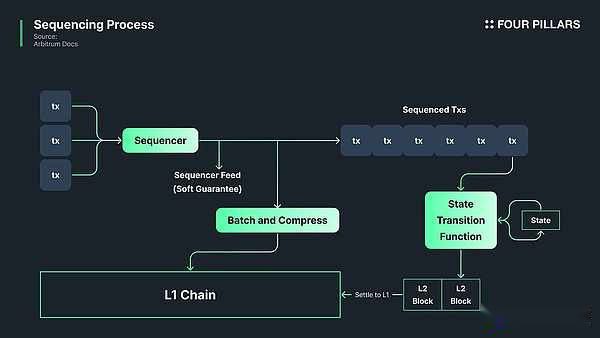
L2 achieves scalability through Rollup, relying on data availability and transaction processing of L1 platforms such as Ethereum.However, there is an inherent limitation in Rollup: although transaction sorting and execution can be done independently, all other processes still need to wait for the final confirmation of L1.
This architecture ensures security and data immutability by directly leveraging L1’s block generation and data availability.However, relying on L1 for final confirmation results in slow transaction processing speed and limited real-time confirmation capabilities, making it difficult to meet real-time requirements from the user’s perspective.
In addition, many L2 sequencers and validation nodes are still centralized at present.This centralization can lead to inefficiencies, such as long transaction confirmation times and possible operational interruptions, which affects the transaction processing efficiency of some Rollups and causes confirmation delays.
Pre-confirmation concept proposed
The concept of pre-confirmation is proposed to solve the problem of inefficient transaction final confirmation in the L2 network.Pre-confirmation allows users to obtain transaction confirmation faster, thereby mitigating the delay and inefficiency common in the Rollup mechanism.
Pre-confirmationWhat problems are designed to solve?
In the Rollup mechanism, the confirmation process after a user submits a transaction to L2 always has the problem of inefficiency.Since the centralized L2 sequencer cannot accurately ensure when a certificate transaction will be confirmed on L1, users are often uncertain about the order and results of the transaction.For example, a user may have to wait for a transaction to be included on L1 for a long time, and if the transaction sequence is wrong or the result is not ideal, it may result in financial losses caused by the executed transaction.
In a highly volatile market environment, the problems of delay and sequential changes are more prominent because users rely on arbitrage and DeFi services.In these cases, transaction delays or sequence changes can directly lead to the loss of opportunities.Even users who conduct ordinary transactions may lack confidence in the time and order of the transactions ultimately confirm on L1, which in turn has doubts about the reliability and ease of use of the blockchain.
Therefore, the pre-confirmation design goal is to compensate for these shortcomings, especially to provide a more convenient and reliable trading experience for users most affected by Rollup’s inefficiency.
Pre-confirmationHow to solve these problems?
Pre-confirmation solves these problems by providing users with inclusion, sorting and execution assurances of transactions.It provides users with “soft confirmation” through a centralized L2 sequencer and issues pre-confirmation credentials to ensure that the transaction will eventually be included on L1.
The main advantage of soft confirmation is that it can improve the user experience.Users can receive confirmation vouchers immediately after submitting the transaction, ensuring that the transaction is included on L1 in the expected order, reducing uncertainty, especially in transactions such as arbitrage that require quick response.In addition, pre-confirmation also enhances users’ trust in the L2 system.As users’ confidence in transaction security processing increases, the overall usage rate of the L2 ecosystem will also increase.As a result, pre-confirmation plays a key role in improving Rollup processing efficiency and convenience.
Is pre-confirmation the final solution?
Although soft confirmation from centralized sequencers can improve user experience with expected sorting and results, it relies on trust in the sorter.Without legal or technical mandatory measures, users can only rely on the reliability of the sequencer.This dependency brings the possibility that transactions may not be included in the correct order, or may not even be included on L1 at all, failing to provide the stability guarantees that users expect.
Taking Taiko as an example to interpret the concept and practice of Based Preconfirmation
Taiko has invested a lot of effort in pre-confirmation-based implementations, as this approach is highly consistent with the core features of Based Rollup.If Based Preconfirmation can successfully introduce Taiko’s framework, it will not only significantly reduce the latency of final confirmation of transactions, but also improve the user experience.In addition, this improvement will activate a variety of previously restricted services, enabling them to run efficiently on the Taiko network.
Before you understand Based Preconfirmation in a deeper way, it is necessary to review some of Taiko’s key features in order to have a more comprehensive understanding of the applicability and advantages of this approach.
Taiko case analysis
Taiko fully demonstrates the core features of Based Rollup.It not only achieves full interoperability with Ethereum infrastructure, but also strives to be fully aligned with Ethereum’s security mechanisms.Taiko adopts the Based Rollup architecture, which means that it does not rely on a centralized sequencer, but rather on Ethereum validators to take on the role of sequencer, responsible for the sorting of transactions and blocks.
That is to say, Taiko’s sequencer is the same type of role as Ethereum’s block proposer.This design gives them special responsibility and incentive mechanisms, such as obtaining maximum extractable value (MEV) rewards and other benefits of sequencer identity.Therefore, when problems arise in Taiko’s L2 sequencing process, these sequencing machines will naturally bear corresponding responsibilities due to their interests in the Ethereum ecosystem.This mechanism has made Taiko significantly different from other Ethereum L2 projects in terms of operational responsibilities.
In addition, it is worth noting that Taiko’s Based Rollup model is designed as a “competition-based Rollup (BCR),” a structure designed to inspire healthy competition.Through an open and license-free design, Taiko ensures decentralization of the system and allows anyone to participate, making the system more fair and transparent.
Pre-confirmation based on Based Rollup
So, what is the pre-confirmation model designed specifically for Based Rollup?The answer is “Based Preconfirmation”.This model aims to replace the traditional soft confirmation mechanism through confirmation that is verified directly on L1.
Based Preconfirmation provides a system where some L1 validators volunteer to participate and provide pre-confirmation services.As sequencers, these validators provide users with verifiable predictions of Rollup transaction results.This approach provides users with trustworthy guarantees for transaction inclusion and sorting, and these guarantees are directly based on L1, thereby enhancing the credibility and reliability of the Rollup process.
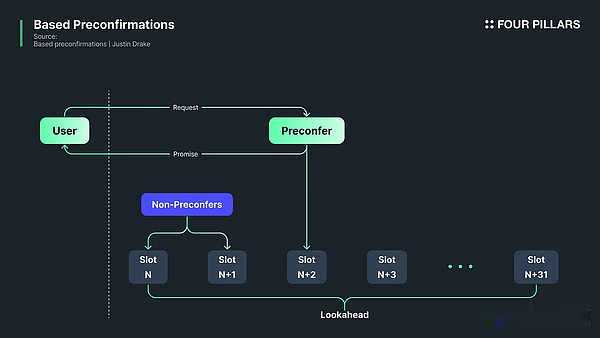
Justin Drake first proposed the concept of Based Preconfirmation and proposed a specific role called “Preconfer”, which can provide users with signature guarantees, clarify the order of transactions and execution status.To ensure the reliability of the commitment, each pre-confirmator is required to pledge a certain amount of margin.If they fail to fulfill their commitments regarding the order of transactions or execution status, they will face penalties from the Slashing mechanism, i.e., loss of partial or full margin.
The Slashing mechanism has been widely used in Ethereum PoS staking and is used to effectively curb malicious behavior.This mechanism not only strengthens the sense of responsibility of the pre-confirmator, but also establishes a certain trust foundation between the user and the pre-confirmator.
Two situations can lead to Slashing penalties for pre-confirmators:
-
Liveness Faults: If the pre-confirmator fails to include the user’s pre-confirmation transaction on the chain for any reason, a life failure will occur.Since activity failure is not always intentional, its punishment is relatively mild.Such failures may arise from network issues or interruptions to the L1 or L2 blockchain, resulting in transactions not being properly included on the chain.To protect the honest pre-confirmator from improper punishment, the amount of penalties for active failure is usually decided by the user in consultation with the pre-confirmator.
-
Safety Faults: If the pre-confirmation transaction is included on the chain but the result is inconsistent with the user’s initial request, a security failure will occur.This inconsistency is entirely the responsibility of the pre-identifier, so the punishment for security failures is often more severe.The margin of the pre-confirmator will be fully forfeited, regardless of whether the problem is intentional or not.
To be a pre-confirmator of the Based Preconfirmation model, a node (usually an L1 block proposer) must accept the conditions of these Slashing mechanisms and pledge the required margin.After approval, the pre-confirmed person can provide services to the user and earn income by charging service fees.
This fee model provides users with significant convenience, allowing them to bypass the inherent delays in the final confirmation of Rollup transactions.For example, after a user submits a pre-confirmation transaction through his personal wallet, he can immediately obtain a confirmation certificate from the pre-confirmator.
Pre-confirmators participating in Based Preconfirmation can not only earn additional revenue by charging fees, but also help optimize Rollup’s transaction confirmation process.This model not only enhances the user experience, but also provides a reliable and efficient final transaction confirmation solution for the entire L2 ecosystem, further enhancing its appeal and practicality.
Why are users willing to pay for pre-confirmation?
This is actually closely related to the core purpose of pre-identification.Users are willing to pay for pre-confirmation because it directly solves the inefficiency of Rollup in the final confirmation process of transactions, bringing significant convenience to users.
For example, when a user submits a pre-confirmation transaction on the L2 blockchain through a personal wallet, the standard transaction may need to wait for the final confirmation, while the user requesting the pre-confirmation can immediately obtain guarantees from the pre-confirmator and complete the transaction without delay.At this time, the user may even see a green checkmark in the wallet interface, clearly indicating that the transaction has been successful.
Take DeFi services as an example. When users exchange tokens on the L2 DeFi platform, pre-confirmation can provide additional guarantees for related transactions.Typically, the quotation rate or fees of a transaction may be inconsistent with the actual completed transaction result due to the delay.However, through pre-confirmation, users can enjoy a fast and efficient final transaction confirmation process, reducing the difference between expected conditions and actual results, thereby obtaining a more reliable service experience.
These application scenarios not only allow developers to provide more accurate services, but also bring users a smoother and more convenient user experience.This dynamic further supports the expansion of the L2 ecosystem, while also contributing to the growth of the wider L1 ecosystem.In addition, for the sequencer of Based Rollup, the additional revenue generated by pre-confirmation provides it with a considerable profit model.This design effectively solves some of the traditional weaknesses of Based Rollup, making it ideal for sequencers, both reliability and appeal.
What are the challenges of Based Preconfirmation?
Based Preconfirmation is still a highly-attractive research area in the Rollup-driven Layer2 project represented by Taiko.Although this mechanism provides a clear solution to improve L2 performance and scalability while maintaining decentralization, it still faces some urgent challenges in practical applications to achieve wider adoption.
First, when Preconfer submits a transaction to a block, users may not be able to obtain an absolute guarantee of transaction inclusion.Although the pre-confirmator provides guarantees for the transaction through pledge margin, this mechanism still cannot fully resolve the problems that the transaction cannot be included due to external interruptions.Especially when the transaction value is higher than the amount of the pre-confirmator’s pledge, the pre-confirmator may abuse its authority to selectively include or exclude certain transactions, which brings potential risks.
Another significant challenge is based on pre-confirmed profit models.The main source of income for pre-confirmators is the pre-confirmation fees paid by users.However, if the number of pre-confirmed users is insufficient or the participation is not high enough, it may lead to market centralization and a tendency to monopolize.In this case, the pre-confirmation fee may be artificially raised, increasing the cost of users to conduct fast and efficient transactions, thereby posing a threat to the healthy development of the pre-confirmation ecosystem.
It is worth noting that the concept of Based Preconfirmation is relatively new and was proposed only about a year ago.It will still take some time to practice and refine it to become the “key tool” to maximize the speed and efficiency of Rollup-driven L2 solutions.However, as Rollup has been firmly established as the core component of Ethereum scalability, further exploring pre-confirmation to improve performance marks an important step in the development of L2 technology.
Taiko, in particular, has made significant progress in promoting the implementation of Based Preconfirmation.At the same time, Taiko collaborated with many partners such as Taiko Gwyneth, Netherlands, Chainbound, Limechain, Primev and Espresso to jointly explore and develop application scenarios of Based Preconfirmation.These collaborations are designed to drive further evolution of the L2 ecosystem, and more relevant details will be discussed in depth in subsequent chapters.
Pre-confirmed ecological panoramic view: flow chart interpretation and project exploration
In this chapter, we will explore which projects are actively researching and advancing pre-identification technology developments in the Rollup-driven L2 ecosystem.Since the ecosystem is still in its early stages of development, we will use a flowchart to more intuitively demonstrate and understand the specific processes of pre-confirmation.
Pre-confirmation flow chart
Pre-affirmation is a complex process that requires close collaboration between L1 and L2, involving multiple roles, each with specific responsibilities.To facilitate a more intuitive understanding of this process, I created a flow chart for a brief overview.It should be noted that this flowchart is intended to help explain the overall logic, so it does not strictly distinguish the different characteristics of Rollup and Based Rollup, but focuses on a general process at the basic level.
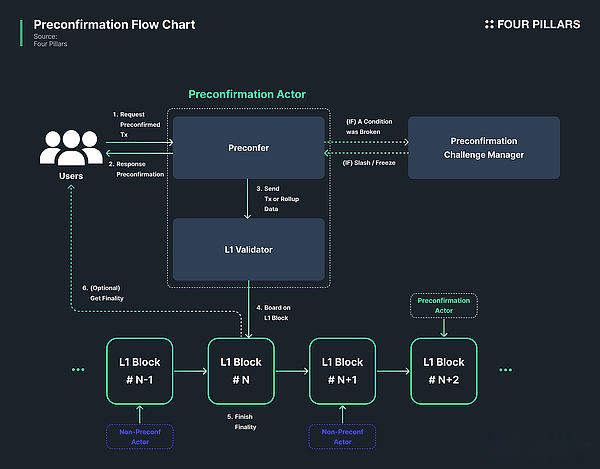
Before understanding the specific steps of the flowchart, we first understand the various roles and functions involved in the pre-confirmation process:
-
User:Individual users using the L1 or L2 network are responsible for creating and submitting transactions.If users want to obtain pre-confirmation protection, they will send the transaction to the pre-confirmator after it is written.
-
Preconferrer:During the pre-confirmation process, the pre-confirmator is responsible for reviewing the transaction and verifying its validity, and then providing the user with a pre-confirmation assurance.Through pre-confirmation, users can quickly obtain the status guarantee of transactions before final settlement.If nodes do not have pre-confirm eligibility, they act as non-pre-confirm actors, dealing mainly with ordinary transactions rather than pre-confirm transactions, similar to standard verification nodes.
-
L1 Validator:Responsible for final verification of transactions and blocks on the L1 network.Once the pre-confirmator submits the transaction data, the L1 verifier will verify it and record the final data into the L1 blockchain to ensure the integrity of the transaction and conformity to consensus rules.
-
Preconfirmation Challenge Manager:When a dispute or problem arises in the pre-confirmation process, the role is responsible for investigating the issue and taking appropriate measures to resolve the dispute.This role plays a key role in maintaining the impartiality and reliability of the pre-confirmation process.
Now, we sort out the specific process of pre-confirmation in the order of the flow chart:
-
The user sends a transaction request to the pre-confirmator among the pre-confirm participants to initiate the pre-confirmation process.
-
The pre-confirmator reviews the transaction and sends a pre-confirmation receipt, promising the user that the transaction will be included in the L1 block, thereby providing the user with preliminary final confirmation guarantees.
-
The pre-confirmator submits the transaction data that needs to be included in the L1 block to the L1 validator.These data may be a single transaction, or a summary data processed by the L2 sequencer.
-
The L1 validator verifies the submitted transaction data or aggregated data and records it in the L1 block to ensure that it complies with the blockchain consensus rules.
-
After a period of time, the L1 block containing transaction data or summary data reaches its finality and the transaction is officially confirmed to be completed.
-
Users can check the final results of the transaction through the L1 node and use relevant information to raise any potential pre-confirmation disputes or challenges if necessary.
-
If a transaction occurs that is not correctly included on L1 as promised, the pre-confirmator will face punishment from the pre-confirm challenge manager, such as being margined by Slash or frozen in its pledged assets.
Exploration of related projects
The following will provide a detailed analysis of the major projects actively involved in the pre-identification ecosystem and their relevant roles in the process.Although these projects occupy a specific role in the flowchart, the responsibilities they actually perform may be slightly different.Therefore, this overview is intended to provide a basic understanding that can serve as a general guide.To keep things clear, items in each category are arranged alphabetically.
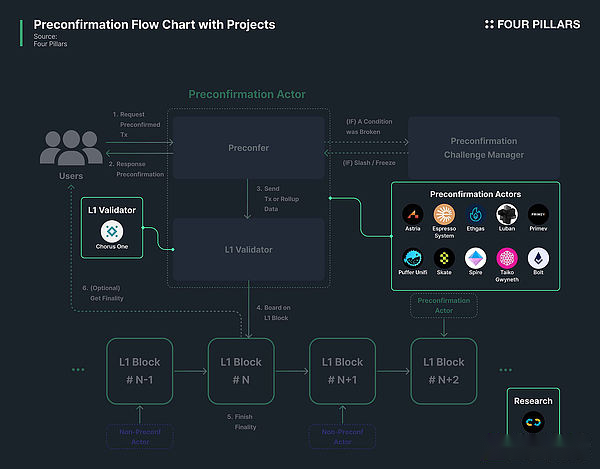
Preconfer Validators
-
Astria:Astria is committed to replacing centralized sequencers with a decentralized sequencer network and supports multiple Rollups to share this network.This design provides Rollup with stronger censorship resistance, faster block endpoints, and seamless cross-rollup interactions.To achieve fast block endpoints, Astria introduced pre-confirmation capabilities, enabling Rollup to provide fast transaction confirmation and enhance censorship resistance, thereby significantly improving the user experience.
-
Bolt by Chainbound:Bolt is a pre-confirmation protocol developed by Chainbound to provide Ethereum users with near-instant transaction confirmation services.Its operation is based on trustless participation mechanisms and economic collateral, and is compatible with the existing MEV-Boost PBS pipeline, creating new revenue opportunities for proposers.The core function of Bolt is L1 pre-confirmation, providing instant end-of-view for basic transactions such as transfers and authorizations, thereby enhancing the user experience.Bolt enhances the system’s censorship resistance by shifting transactional inclusion responsibilities from centralized block builders to proposers.At the same time, the mortgage proposer registration mechanism ensures a trustless environment that flexibly supports various types of smart contracts.
-
Espresso System:Espresso System is a protocol dedicated to enhancing interoperability of blockchain ecosystems.It adopts the HotShot Byzantine Fault Tolerance (BFT) consensus protocol to achieve transaction order between multiple chains and fast endpoints in data.The Espresso System includes Espresso Network and Espresso Marketplace, which work together to provide fast transaction finality and efficient interoperability, with the goal of improving the scalability and security of the blockchain ecosystem.
-
Ethgas:Ethgas is a market for trading block space. Transaction matching is managed by a centralized system and on-chain processes are executed through smart contracts.Ethgas offers two main functions:Includes pre-confirmation(Make sure the transaction is included within the specified Gas limit) andPerform pre-confirmation(Make sure the transaction reaches a specific state or result).Ethgas focuses on protecting transaction privacy in block space transactions and is known for its neutral operational goals.
-
Luban:Luban focuses on developing a decentralized sequencing layer to connect transaction data between the Ethereum network and Rollup.The sequencing layer is designed as a decentralized system that separates proposal and execution roles.Luban’s pre-confirmation feature significantly improves transaction reliability by ensuring transaction executability before being included in the Ethereum network, while helping to optimize key factors such as transaction fees, Gas prices and MEVs.
-
Primev: Primev is developing a proposer network integrating with MEVs, combining pre-confirmation with MEV capabilities to build an efficient and reliable point-to-point network.This network records promises for Ethereum transaction execution and incentivizes proposers through reward or punishment mechanisms.Primev allows MEV participants to set specific execution conditions for their transactions, and block builders and validators can promise to meet these conditions, ensuring pre-confirmation of transactions.Based on EIP-4337, Primev supports flexible pre-confirmation and Gas fee options, which not only improves transaction processing efficiency, but also further optimizes the user experience.
-
Puffer Unifi: Puffer Unifi’s Active Validated Services (AVS) is built on EigenLayer and focuses on solving pre-confirmation challenges in the Ethereum ecosystem, especially in the Based Rollup architecture.Puffer Unifi AVS uses EigenLayer’s re-staking function to support the pre-confirmation participation mechanism, aiming to improve the efficiency of final transaction confirmation.With the development of Based Rollup, the demand for reliable pre-confirmation providers has been growing, and Puffer Unifi AVS aims to meet this demand.Its ultimate vision is to achieve efficient pre-confirmation without changing the core protocol, thereby promoting sustainable growth of the Ethereum ecosystem.
-
Skate: Skate’s pre-confirmation AVS relies on re-staking assets on EigenLayer to provide economic security guarantees for all cross-chain operations.This AVS verifies the bundled data and information required for cross-chain transactions, which are then signed by Skate’s repeater and ready for execution.Through this process, Skate AVS realizes pre-confirmation of data, significantly improving the reliability and efficiency of cross-chain transactions.
-
Spire: Spire’s Based Stack is a Rollup framework for Based Ethereum, which is specially designed to build application chains (App Chains) for developers.This framework allows application chains to interact directly with Ethereum, customize its sequencing method, supports cross-chain redemption and other functions, and optimizes the user experience through pre-confirmation.Based Stack supports multiple execution environments, guarantees the sequencing revenue of the application chain and maintains compatibility with traditional shared sequencers.As an open source project, Based Stack provides developers with the complete tools and resources needed to build and manage application chains, thereby promoting interoperability of application chain development and the Ethereum ecosystem.
-
Taiko Gwyneth: Taiko Gwyneth is a Rollup design that Taiko is developing and is classified as a based Rollup architecture.The goal is to achieve full interoperability with Ethereum while managing transaction ordering directly on Ethereum.This design takes full advantage of Ethereum’s security and decentralized features while providing high throughput and fast final confirmation.Currently, Taiko is running a proposer mechanism to assist block creation and explore pre-confirmation mechanisms to promote profitable block production within the community.This mechanism is designed to optimize block time scheduling and data release efficiency.To achieve these goals, Taiko is working in depth with projects such as Nethermind and Gattaca.
L1 Verifier
-
Chorus One: Chorus One is a project that provides verification services and infrastructure for blockchain networks, focusing on staking services in multiple protocols to enhance network stability and security.As an L1 validator, Chorus One’s role is to verify transactions and generate blocks, thereby improving the reliability and efficiency of the entire network.Recently, Chorus One has shown great interest in pre-confirmation technology and has even held a related special event during Devcon 2024.
Research
-
Nethermind:Nethermind is a project dedicated to the development of Ethereum clients and tools, and its core goal is to improve the performance and stability of blockchain networks.By introducing advanced optimization technologies, Nethermind actively promotes the increase in Ethereum network transaction throughput.Nethermind has been conducting in-depth research on pre-confirmation technology and has submitted a proposal to Taiko’s funding program to accelerate the deployment of pre-confirmation capabilities on the Taiko main network.This proposal is based on Nethermind’s RFP-001 project and is implemented in two phases: the first phase will test the pre-confirmation function among limited authorized participants; the second phase plans to gradually expand the application scope of pre-confirmation.
Looking to the future
Taiko and many Based Rollup’s Layer2 projects, regardless of whether they adopt the Based Rollup architecture, are working hard to optimize the inefficient final transaction confirmation process in traditional Rollup.By introducing the concept of preconfirmation, these projects are building a transaction confirmation system that enables users to confirm transactions faster and more reliably.With this approach, these projects continue to explore how to enhance user experience and build user trust.
Taiko makes full use of its positioning as the Layer 2 project of Based Rollup and actively promotes the implementation of Based Preconfirmation mechanism, thereby achieving comprehensive interoperability and decentralization with Ethereum.Taiko greatly improves transaction processing speed and reliability by providing users with fast and reliable final transaction confirmation guarantees, thereby significantly improving the user experience.
However, several industry experts, including Ed Felten of Arbitrum, point out that there is still a lack of mature middleware that fully supports pre-confirmation.This shows that the maturity of pre-confirmation technology and the profit model of pre-conferors still face challenges, and these problems need to be further solved urgently.
As mentioned in this article, more and more projects and participants are actively entering the pre-confirmation field, each bringing unique innovative solutions to improve the performance and efficiency of Ethereum Layer2.This trend also conforms to the general law of continuous optimization of system concepts after initial implementation.I believe that this stage marks an important node in the evolution of L2 systems and is also an exciting and positive development in the current L2 ecosystem.
Improve user convenience through pre-confirmation will not only have a profound impact on areas that focus on speed and efficiency such as DeFi and gaming, but may also reconnect Ethereum with the previously scattered ecological parts by improving the performance of Ethereum Layer2.This performance improvement may enable more Type-1 Ethereum Layer2 projects to achieve deep integration with Ethereum, thus unlocking potential that was previously difficult to obtain due to speed limitations.These progress will inevitably have a profound impact on the entire Ethereum ecosystem.
Pre-confirmation remains a challenging and rough road.However, pioneers like Taiko are facing difficulties and focusing on providing users with more convenience.Innovation has never been an easy task, but as a supporter of Ethereum and its Layer2 ecosystem, I pay my sincere respect and encouragement to their efforts.

